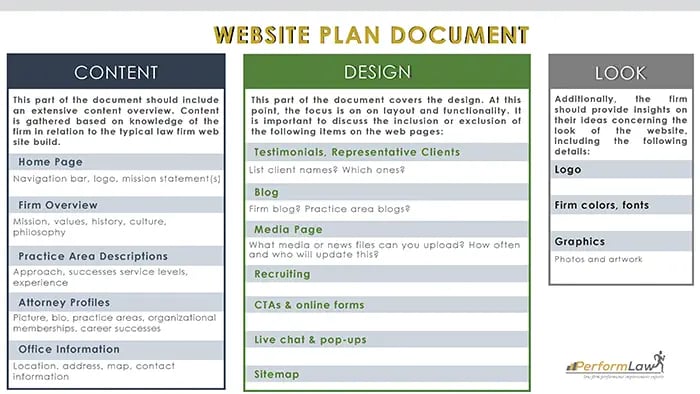A decent website is now considered a fundamental marketing tool for law firms to maintain and grow a sustainable client base.
Sure; a lot of business is generated through referrals. However, client prospects will undoubtedly review a firm’s website and attorney profiles for further verification of credentials. Along with showcasing the firm's expertise to prospective clients, a strong website also provides relevant practice areas and case information to targeted visitors, showing them that the firm understands their legal issues and needs. Well-crafted content keeps visitors coming back to the site, building the trust and loyalty of both existing and future clients.
While a solid website is clearly important, it is almost always a challenge for law firms to build a new website or redesign an existing one. Law firms are often frustrated with the time and money it takes to develop a website they aren't completely satisfied with in the end. This typically occurs when a law firm has a poor development process or does not have an internal marketing staff.
But there is hope for law firms looking to build a new website. We have found that when they follow the basic suggestions described below, they save much time, money, and frustration.
PREPARATION
To begin a website project, a law firm should select an internal decision-making team, designating one person as the website authority. When too many people are involved in a website project, the site quickly loses precedence. Engaging someone from the firm’s management team who has an interest in the project can help to ensure that the project remains a priority. Firms should also consider hiring an outside consultant to oversee the completion of the website. Consultants such as PerformLaw are familiar with the various components and processes involved in the development of a strong law firm website and can coordinate the details between the law firm and web design company. With a central decision maker in place, the more likely the project will be done right and in an efficient amount of time.
Content
Website development primarily includes content and design. Before a web designer is hired or graphics and design is discussed, firms should prioritize and plan the content of the website. Content is viewed as the foundation of the website. The most effective website builds are largely a result of the quality content and direction provided to the designer at the beginning of the process.
The firm’s brand image and the message it wants to communicate should also be planned before involving a web designer. While web designers often handle both the branding and web design of the website, we believe these processes should be managed separately.
The firm’s attorneys and staff involved in the website project should answer the following questions:
- What is the firm’s mission/vision?
- How do you describe the firm’s culture, history?
- How do you describe the work in specific practice areas?
- What information do you want to feature about the attorneys?
- How does your firm help clients better than other law firms? What makes you different? What makes you more effective?
Based on the answers, the firm should organize the content for placement on their future website, considering the standard law firm website structure.
Design
The second phase of the preparation stage focuses on the website’s design.
Managing attorneys should place high-level thought into what graphics and layouts they wish to feature throughout their new website. They can easily do this by reviewing the websites of competitive law firms, indicating what they like and don’t like about these sites, as well as other websites they frequently visit. This means of preparation not only speeds up the actual development of the website, but also helps to control costs. It prevents a lot of wasted time since it provides the web developer a clear direction and clarifies important website characteristics such as site layout, functionality and graphics.
Website plan document
To complete the Preparation stage, a firm should outline all of the ideas regarding the website’s content and design in a website plan document. While web designers and copywriters will make valuable suggestions and recommendations once they are hired, the firm can streamline the process and ensure the developers meet the firm’s quality expectations. Completing this step can save much time and frustration.

IMPLEMENTATION
Website Platform
Once the firm has completed the preparation process and website document, it is time to decide the course of implementation. Does the firm wish to hire a web designer that will use a website platform like WordPress or Webflow to build a customized website? Or does the firm want to use an automated website builder like SquareSpace or Wix to create their own website? These are user-friendly template-based platforms, meaning that a web designer is not necessarily required. While Option 2 is the more affordable solution, we only recommend this option if the firm employs someone with web design experience. Otherwise, hiring a web designer is the smart choice.
Copywriting
A hired web designer’s strength is typically found in the design of the website. While some web companies also offer copywriting services, a law firm may need to hire an outside copywriter to assist with website content. Here, it is important to look for experienced legal copywriters, not only to provide quality content on the website, but also to guarantee a certain level of search engine performance. The need for outside copywriting support depends on the firm’s preparation, as outlined above, and ability in describing its mission, culture and approach.
In the end, reviewing the competition’s web presence, as well as developing and structuring content ideas and drafts, will help to streamline the website creation or revision process, saving time and costs. Once the design is approved, the copy needs to be inserted and the website can go live.
MODIFICATION
After the website is created, a certain degree of modifying or fine-tuning will help with search engine optimization and website lead generation. If the web designer is not specialized in law firms, the copywriter needs to have specific legal competence. Based on the firm’s marketing effectiveness expectations, a consultant with legal (online) marketing expertise could be hired to review the website performance, as well as search engine performance factors. The copywriter could provide valuable recommendations to optimize the aforementioned, as well as website-generated lead flows and advertising methods. The main goal of this final web development step is to optimize brand and service value communication and to increase lead capture and conversion rates
